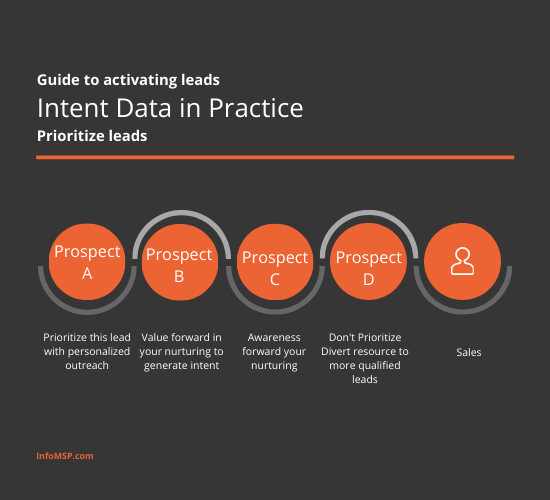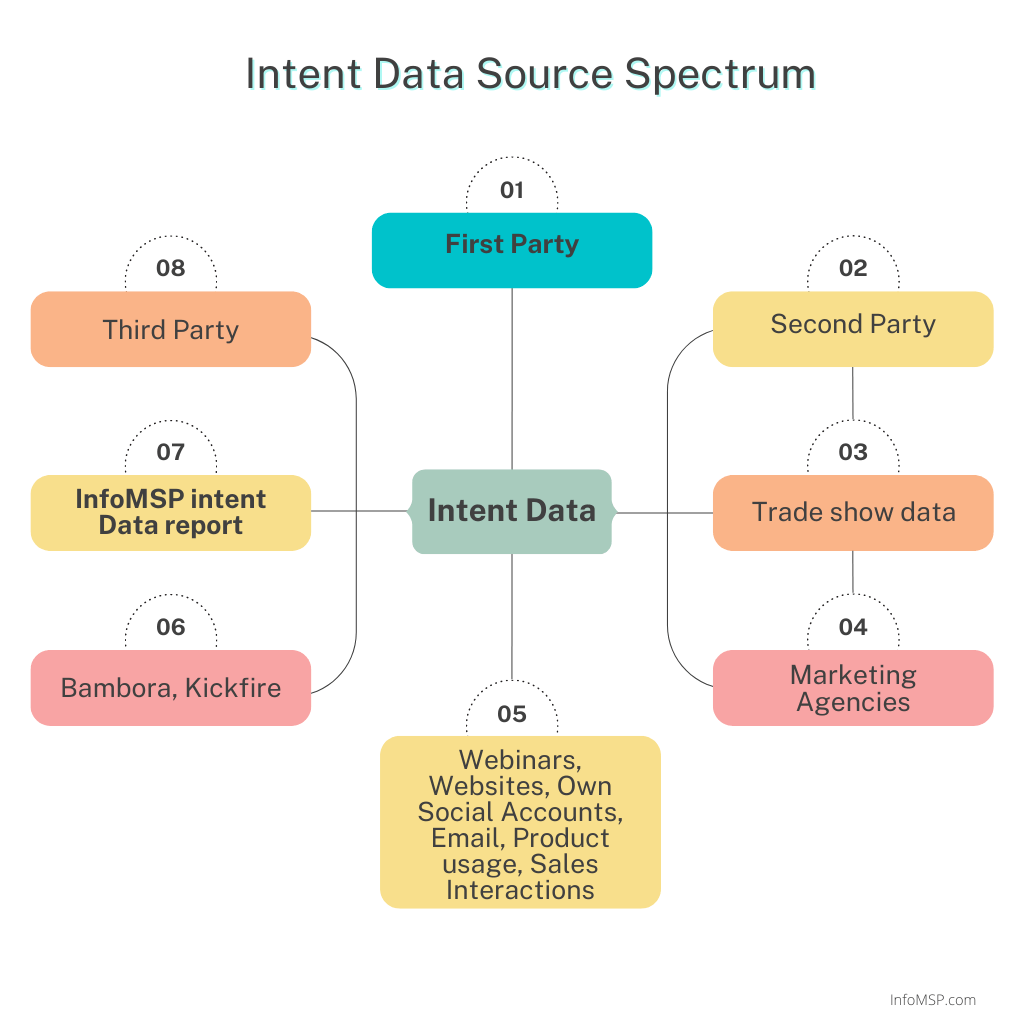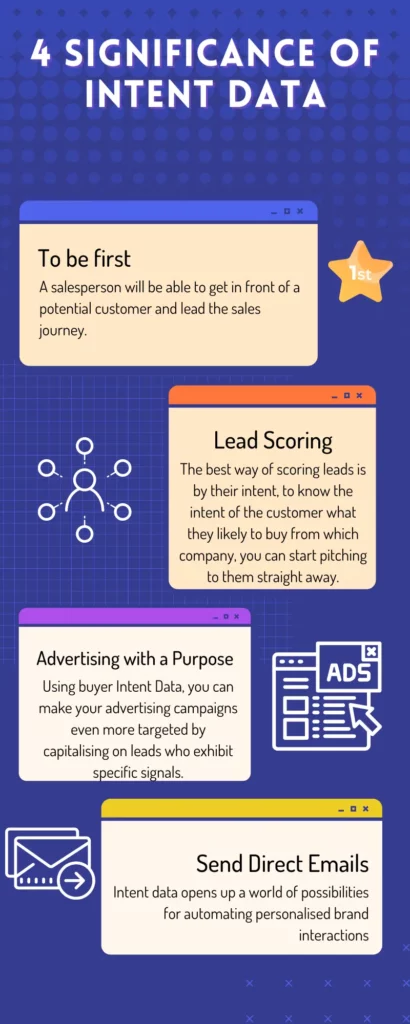Know What Is Intent Data and How Can It Help B2B Sales?
What is Intent Data?
Intent data is a type of behavioural signals dataset that demonstrates whether or not your customers intend to purchase a product. It predicts whether a buyer will purchase your (or comparable) goods or services. It is a huge step forward in data-driven marketing and sales.
Intent data can be utilised to make more efficient and confident marketing and sales decisions.
Sales and marketing departments can use InfoMSP Intent Data Report to identify accounts that are researching themes related to their brand through online consumption of:
Armed with these behavioural cues, sales and marketing professionals can prioritise accounts that are spiking on relevant themes over equally qualified customers who do not exhibit intent.
The success of B2B sales and marketing is strongly reliant on data. However, simply using the data to reach out to prospects is insufficient. Every skilled marketer and sales professional understands the potential value of B2B Intent data and its ability to aid in the achievement of broad corporate objectives.
B2B intent data, when used effectively, increases conversions and sales.

Organizations that can gather and use online intent data can engage buyers considerably earlier in the process, guiding their decision-making before the prospect’s interest is even visible to a competition.
And, in most cases, the first salesperson through the door wins the deal.
Forward-thinking businesses, and buying intent indicators provide a big opportunity.
Obtaining high-quality leads from B2B firms is one of the most difficult challenges for sales and marketing professionals.
Buyer intent data can be used in a variety of ways, including:
- Identifying qualified leads: As previously said, understanding buyer intent allows you to prioritise B2B organisations that want to buy from you.
- Making better advertisements: Instead of launching broad marketing campaigns, you may use B2B buyer intent data to personalise your message and target individual firms or employees (for example, on LinkedIn), knowing they are interested in your products or services.
- Increase your sales outreach: With buyer intent data at their disposal, your sales team can better prepare for calls and adapt their approach based on the solution that a specific company is interested in.
What is the significance of intent data?
As per surveys, an average B2B prospect is already 67 percent of the way through the purchasing journey before engaging with a salesperson. Integrating prospect signals with buyer intent data provides a more precise overview to assist the organisation leverage consumer insights. This signifies that prospects have showed an interest in purchasing a product or service, and a sales representative must focus on the remaining 33percentage points to seal the deal.

Types of intent data?
To comprehend where intent data originates, you must first understand the various kinds of intent data. There are two major aspects to consider.
1.first-party and 2. third-party intent data.
First-party intent data: Any intent data collected from your own site is considered first-party intent data. This might include forms filled out for password-protected material or IP addresses acquired from visitors.
Third Party intent data: Third-party intent data is any intent data collected from another website.
Understanding customer intent is essential for any marketer or salesperson trying to increase their success rate, as well as those looking for new strategies to get ahead. Understanding prospect behavior and triggers assists organisations in determining what motivates consumers to purchase and when they do so. With this data, marketing and sales teams may target a certain demographic and design a personalised approach for them on demand, boosting the possibility of a purchase decision.
Usefulness of B2B intent data for sales
1.To be first
Salespersons want to be first, they know it pays to be first person in touch
A salesperson will be able to get in front of a potential customer and lead the sales journey. Knowledge of potential customers, who are just starting to look around, means you already have a start.
2.Scoring leads
The best way of scoring leads is by their intent, to know the intent of the customer what they likely to buy from which company, you can start pitching to them straight away.
Among the most useful components of intent data is the ability to rank prospects based on their level of intent. This will generate a list of targets in the order of where you should contact first.
3. Cold Calling
Knowing what types of organisations a prospect is considering will provide you with insights into why they are considering your solution. This means you're not looking for pain issues at the beginning of your cold call, and depending on the type of company you are, you can have a more valuable conversation with them. You've previously met them.
4. Retaining customers
Retaining customers is less expensive than obtaining new ones. Intent data allows businesses to see the solutions that their current client base is contemplating. They may contain additional features that you do not now provide or alternative solutions to your own.
5. Advertising with a Purpose
Using buyer Intent Data, you can make your advertising campaigns even more targeted by capitalising on leads who exhibit specific signals. When you can connect the dots between what your B2B buyers require and their buying signals, you can start offering relevant information that will assist them reach their objectives while also creating an opportunity for you. That way, you won't waste any of your advertising dollars on people who are simply interested in your product and have no intention of purchasing it.
6. Send Direct Emails That Perform
Intent data opens up a world of possibilities for automating personalised brand interactions, especially if you can use your integrations to determine whether the visitor fits your ideal customer profile (ICP). Prospect marketing, including direct mail, may and should be influenced by intent data. The most successful channel is integrated, branded, and personalised direct mail, which exceeds regular direct mail.

How Intent Data is Collected?
Intent Data is obtained from three different sources:
Independent Websites or Portals: Customers information is collected and shared by independent websites or portals. Although they cannot collect large amounts of data, they can handle their users opt-in and authorization to share their data more than adequately.
Bidstream: Bid stream data is an abbreviation for bidstream location data. The "bidstream" is essentially a network of advertising requests. These demands are specialised to delivering advertisements to mobile devices. The bidstream data is made up of all of the data that is supplied along with a bid request. The ad is then used to scrape the keywords and visitor information on that site without the knowledge of the website owner or visitor.
Publisher cooperatives : Publishing cooperatives can provide a variety of services to meet the needs of their members. These functions could include providing shared services, bargaining, negotiating, and purchasing on behalf of members, and marketing, selling, and distributing publisher content. Each newspaper or website need the consent of its visitors on the first interaction.
Initiate integrating buyer intent data into your prospecting efforts.
Intent Data can be a powerful predictor of which accounts are most likely to purchase your product or service. Intent data is extremely valuable on its own, but it works best when combined with other data pieces to create a holistic scoring model that also takes into account qualifying criteria and engagement.
You receive access to precise and complete B2B data, including firmographic and technographic information on your ideal customer profile (ICP), as well as buyer Intent Data, with InfoMSP Intent Data Report.
Intent data faq
Intent data is a type of behavioural signals dataset that demonstrates whether or not your customers intend to purchase a product.
Organizations that can gather and use online intent data can engage buyers considerably earlier in the process, guiding their decision-making before the prospect’s interest is even visible to a competition.
Third-party intent data is any intent data collected from another website. For example InfoMSP Intent Data Report
The 4 methods of Intent Data can be classified as: 1. To Be First, 2. Lead scoring, Advertising with a purpose and 4. Send Direct emails
